The term "to disavow backlinks" appeared in SEO lingo due to the major shake-up from Google’s 2012 Penguin update targeting sites involved in spammy linking for soaring rankings.
As a result, many websites took a major hit from the update, whether they intended to link to spammy sites or not. Multiple traffic-dependent businesses were left reeling. To help them bounce back, Google launched its Disavow Tool in the Search Console on October 16, 2012, offering a glimmer of hope for regaining lost rankings.
In short, the Disavow Tool was designed for SEOs to directly inform Google which links to ignore due to spam or harmful content.
After 12 years upon its launch, there’s still a lot of debate on whether webmasters really need the Disavow Tool. In our 2026 survey of SEO experts, 61% of participants said they DON’T use it at all.

Here are a couple of possible explanations 👇:
👉 The tool was initially introduced to help disavow bad backlinks, however, very soon black-hatters twisted it to harm competitors by flagging their links as spam and tank their rankings. Realizing the rise of negative SEO, Google began shifting its stance. Starting around 2019, Google lowkey mentioned that disavowing links ISN’T necessary unless you’ve received a penalty OR had big numbers of low-quality links pointing to your site.
👉 With Google’s spam detection improving, blatant spam links are typically sifted out and overlooked, meaning they don’t affect your website whatsoever. So, there's no need to stress over how to disavow toxic backlinks on your own – Google will likely take care of it for you.
👉 Disavowing backlinks probably won’t make much of a difference for those who religiously stick to organic link acquisition. If you’re already familiar with the quality of each link you’ve built, and your backlink profile is small OR you’re in a less competitive niche, most spammy links won’t be taken into account.
👉 Whether or not you use the Disavow Tool, it’s not a ranking factor on its own. What REALLY matters are the links themselves! To maintain strong organic rankings, it’s crucial to focus on the quality of your backlinks. The Disavow Tool will only help you point to the most problematic spammy links, but Google will weed out the rest automatically.
👉 Last but not least, we are just people! We all make mistakes and can casually disavow a link that’s actually fine. So, using the Disavow Tool should be done with caution — once a link is disavowed, you can't get it back, which means you could lose some valuable link juice.
Anyway, there are still MANY good reasons to disavow toxic backlinks on your own too. In this post, we’ll talk about why, when, and how to disavow backlinks for your own SEO good.
What is Backlinks Disavow?
Even the word “disavow” itself tells you what it is all about — it's for “disowning” or rejecting unwanted backlinks that could harm your site, especially when all attempts to remove them manually haven’t worked.
So, in more technical SEO terms, ¨backlinks disavow¨ is the process of submitting certain links to Google’s Disavow Tool in Search Console, requesting that these should be ignored when determining your website's ranking.
💡 Pro-tip! The “should” aspect here highlights that links you consider harmful — like low-quality, irrelevant, toxic links, or links from hacked, spammy, de-indexed, or penalized sites — are simply a SUGGESTION for Google to review. It DOESN’T guarantee that Google will not consider such links when calculating your ranking.
3 Reasons To Disavow Bad Backlinks
As we’ve said before, webmasters, like anyone, can make mistakes in link analysis. That’s why the Disavow Tool should only be used when absolutely necessary, like in these cases:
Manual action
Google has been clear about when to use the Disavow Tool — mainly if you've already been hit with a manual penalty or suspect one is coming soon because of spammy links that Google will likely catch on its own.
If you have a manual action against your site for unnatural links to your site, or if you think you’re about to get such a manual action (because of paid links or other link schemes that violate our quality guidelines), you should try to remove the links from the other site to your site.
If you can’t remove those links yourself, or get them removed, then you should disavow the URLs of the questionable pages or domains that link to your website.
Source: Search Console Help
I only advise uploading a disavow file if a site has been hit with a manual action. From experience, it can take weeks or months to recover – but some websites actually never recover at all. It really depends on the severity of the manual action and this can differ from site to site.
Ranking & traffic drop
Whenever you notice a sudden drop in rankings or traffic that seems to line up with a major algorithm update or link-based Google policy, it might mean that some bad links in your profile have been flagged. In that case, it’s time to disavow toxic backlinks ASAP.
💡 Pro-tip! Such links could be anything from recent additions to olden links that slipped under the radar, but it’s definitely worth a check!
Another reason to disavow bad backlinks is when your traffic stays flat, no matter how often you update content or tweak your on-page SEO — there’s likely something holding you back.
Finally, ranking and traffic drops can also happen if there’s a sudden wave of spammy links — often a sign of a negative SEO attack from competitors.
Backlink profile cleaning
Don’t overlook the importance of cleaning your backlink profile from harmful links. Yes, regular check-ups take time, but they give you a clear view of what's happening, allowing you to quickly prevent negative SEO manifestations, like poor linking shown below:
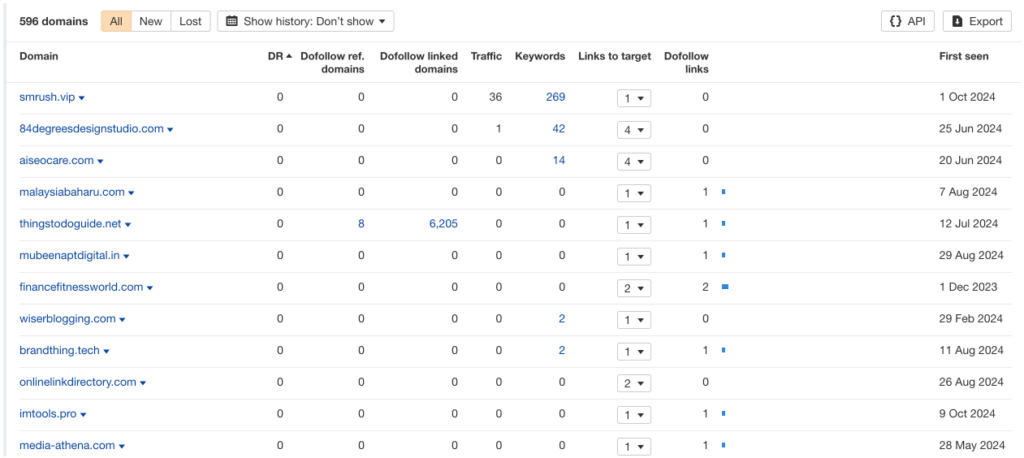
Speaking of what to steer clear of… Save this handy checklist!
🚫 Dubious TLDs – while links from certain top-level domains aren’t always bad, it’s best to avoid such on .tk, .gq, .top, .ml, or similar.
🚫 Hacked site backlinks – appear to be super risky as you don’t really know what kind of malicious code they might contain as well as spam they are linked to.
🚫 Press Release backlinks – particularly those bearing commercial anchor texts (as per Spam Policies) should definitely included in a curated disavow file.
🚫 Directory backlinks – these are prime candidates for disavowing since many directories today exist solely to pass PageRank.
Do You Need To Disavow Backlinks in 2026?
There’s definitely a split on this within the SEO community. Let’s take a closer look at the difference in views!
Opinion 1: Nope!
This SEO camp believes backlinks should ONLY be disavowed when Google prescribes it — like in the case of manual actions or when you spot spammy links. Outside of that, they see it as unnecessary and outdated.
Here’s what Google’s webmaster guru, John Mueller, tweeted on May 4, 2024.
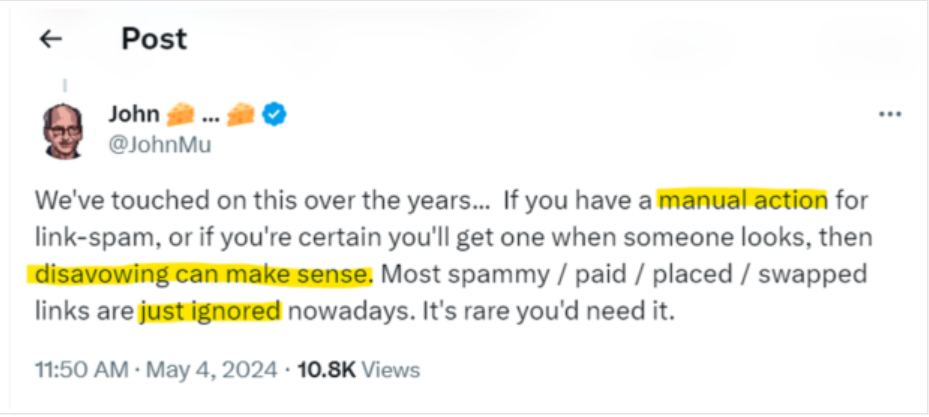

Moreover, he even questions the whole idea of "toxic links," suggesting it’s more of a concept pushed by SEO tools and agencies looking to profit from backlinks disavow, rather than a true necessity.
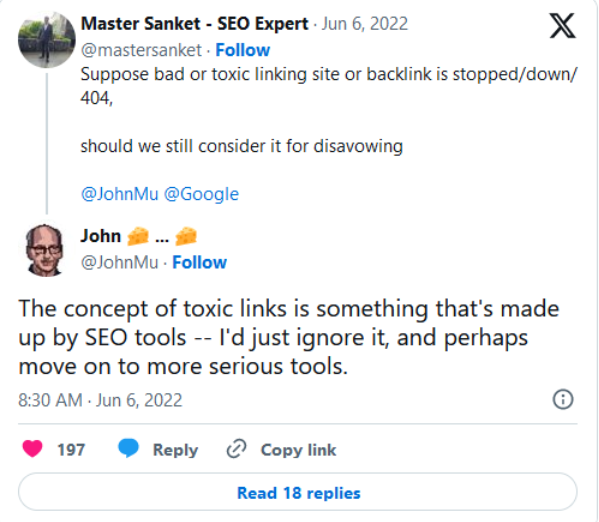
Or check out this one!
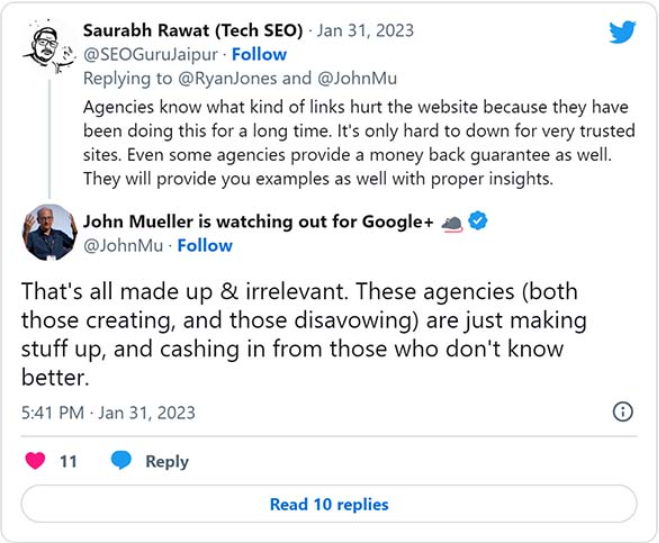
Even if you DO disavow toxic backlinks, John Mueller claims it won’t magically restore your rankings, once again raising the topic of paying for SEO tools that “overpromise”.

In fact, overdoing the disavow process CAN hurt your rankings to a certain extent. This was demonstrated in a recent experiment by Patrick Stox, where he disavowed all “toxic” and “potentially toxic” backlinks Ahrefs had to its three blog posts.
🔎 Results: Before disavowing, traffic to these posts was slowly trending up, according to GSC. After disavowing, traffic dropped by 7.1%. Overall, the experiment showed that disavowing seemed to hurt one page a little, possibly helped another, and had no impact on the third. But in the end, it didn’t bring much, if any, positive result.
In that end, the “uselessness” of backlink disavowing was recently highlighted when John Mueller hinted that Google might eventually retire the Disavow Tool altogether!

Is there anyone who disagrees? Always!
Cyrus Shepard ran an experiment, disavowing over 10,000 backlinks from 1,473 domains, including Moz, Ahrefs, and Semrush.
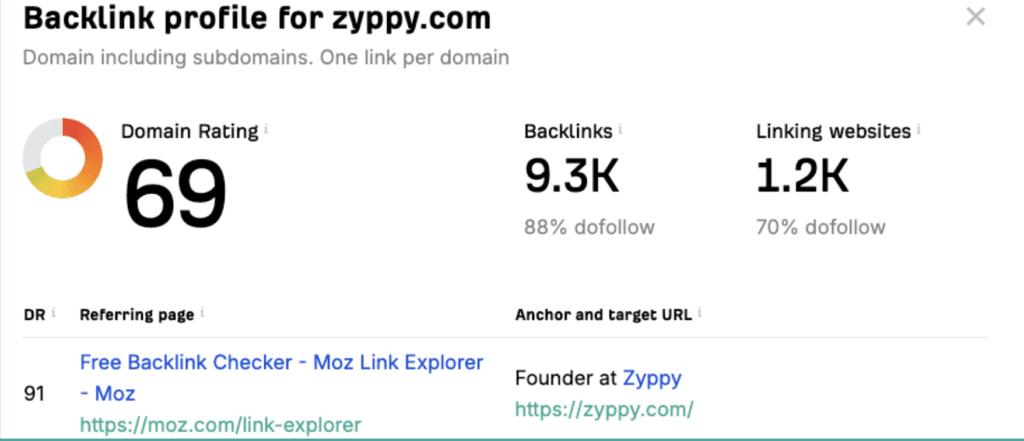
The result? No significant impact on traffic.
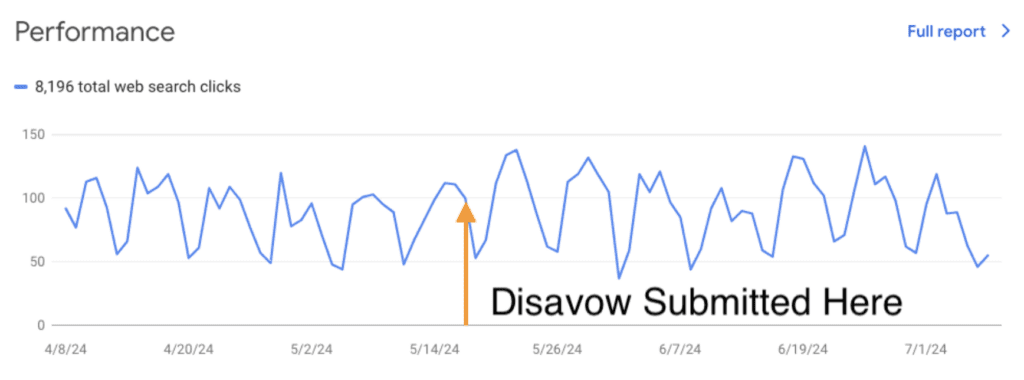
A brief spike followed the submission, but it was likely due to routine updates.
Weeks later, Google Search Console showed a sharp drop in reported backlinks, but this was a reporting bug, and the numbers returned to normal.
Shepard suggests three reasons for the lack of impact:
- Google may have ignored the disavow file, treating it as a suggestion.
- The effect might take longer to show, similar to how backlinks influence rankings over time.
- Not enough links were disavowed, as some impactful ones may have been missed.
To dig deeper, he later submitted a new disavow file targeting low-quality and spam links.
Opinion 2: Yes, but mindfully!
On the contrary, such SEO experts like Bruce Clay still see the probable need for disavowing toxic backlinks, simply because:
Few sites have a flawless link profile, so it’s important to set aside time for cleaning up what’s no longer serving you. As sites grow older, they can attract unwanted links, and some that were once helpful may now be broken or even harmful.
If you’re building a new SEO strategy, it’s worth revisiting your current links to see which ones could hurt you down the road. After all, if your site is thriving, you’ll want to keep it that way by avoiding anything that could jeopardize its success.
In the same way, Marie Haynes emphasizes, SEOs should take a hands-on approach by proactively identifying and removing questionable links themselves, rather than solely relying on SEO tools.
I find that the truly toxic links…the ones that could have the potential to harm your site algorithmically are rarely returned by an SEO tool.
So, it’s important to trust your SEO gut when it comes to links — especially when it comes to tracking the slightest link “manipulations” that could later in time be seen by Google as acute spam or schemes to doctor up PageRank. Better to clean it up before a manual action comes your way!
There are two situations where we will recommend to our clients a thorough link audit followed by filing a disavow:
- The site has a manual action for unnatural links in GSC.
- The site has a very large number of links that we feel the webspam team would consider to be “manipulative.
However, for your backlink disavowing to work effectively when minor issues arise, you need to ensure that a significant portion of your links are naturally built by YOU.
The cases where we do feel that we’ve seen improvement after disavowing, are sites that had link profiles that were a mixture of good natural mentions and a large number of self-made links for SEO – usually links inserted within articles published on other sites.
Finally, there's a super interesting point made by Michael Cottam. In his article on negative SEO and using disavows against it, Michael expresses some skepticism about Google's ability to instantly spot and ignore ALL spammy links, even though it's definitely improving at it.
The vast majority of people discussing [Google’s ability to detect toxic links] are focused on whether or not links are being counted against you, like a penalty. But Google is ALSO looking at the CONTENT on pages that link to your site as a signal of what you’re good at, or well known and trusted for.
For this reason, he brings up examples of injected websites.
By the time we discovered the toxic links, many of the webmasters from the hacked sites had found those injected pages and deleted them. But….Google “remembers” pages that 404 for many, many months. So Google is still considering the content and links from the last time they were able to fetch those pages.
This highlights the importance of submitting such links to the disavow file as soon as possible, as Google may still have some inertia in calculating your rankings based on its last interaction with the toxic link.
On our part, we were curious to see how the SEO community feels about backlink disavowing nearly a year after our last survey at Editorial.Link. So, we decided to run a LinkedIn poll to gather some fresh stats.
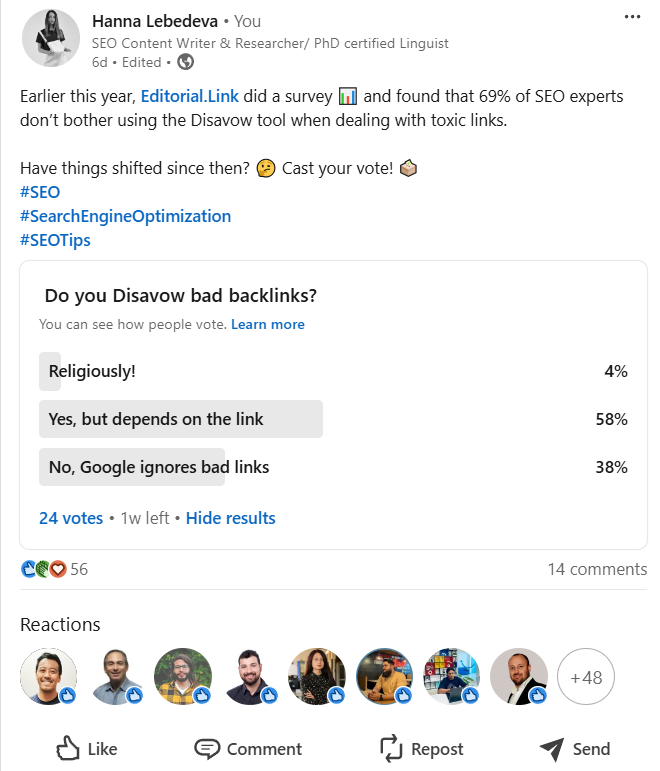
Turns out, 58% of SEOs surveyed SEOs DO disavow backlinks — but selectively, depending on each link’s quality.
The danger with the disavow tool is that you can easily destroy page ranking signals by disavowing good links. In 3 years of managing a national franchise SEO strategy, I used the disavow tool once, and it was an extreme case.
I think the most important thing to note here is that using the disavow tool should be done with caution and only in extreme situations where you have evidence of affected SEO performance. SEMrush’s toxic link report is not enough to disavow links. Be careful!
A slightly smaller group, 38% of SEO experts, feel there’s no need for double work — they’re confident Google will eventually handle the bad links on its own.
I’d say there is some use in using the disavowal tool if it’s obvious spam or links you don’t want to be in your index. I know that Google says they can automatically detect these but with them deploying machine learning at scale I think it can’t hurt, at the least.
It’s unlikely things have shifted much; many SEO experts still avoid using the Disavow tool, often relying on Google’s algorithms to ignore low-quality links. The tool is mainly used for severe cases where toxic links directly impact rankings.
And a tiny percentage — just 4% — say they regularly disavow every suspicious backlink they find.
So, what’s the takeaway here? It’s clear that in 2025, backlink disavowing is still going strong, but it definitely requires a thoughtful approach!
⚠️Bottom Line⚠️The debate over using the Disavow Tool will keep going as long as it’s an option in Google Search Console — it's just common sense!
Regardless, here at Editorial.Link, we recommend backlink disavowing for smaller websites — especially those highly dependent on organic rankings for business success. This includes brands, small media outlets, marketplaces, or anything reliant on online visibility, ad conversions, clicks, and sales.
For websites like Ahrefs, charities, NGOs, and major informational resources, and alike there’s less need to disavow bad backlinks. Google tends to index these sites first, so if there are any suspicious links, it’s likely they will be handled without anyone’s help.
How To Find Bad/Toxic/Spammy Backlinks?
Earlier, we mentioned cleaning up your backlink profile as a valid reason to use the Disavow Tool, which involves identifying and reporting undesirable links (see our toxic link checklist!) that occasionally creep in. So, your first step is to run a thorough backlink audit.
When analyzing your backlinks, you can quickly spot one that needs disavowing by looking for these signs:
🧹 Poor domain scores 🗑️
🧹 Zero relevance to your website 🗑️
🧹 Redirection to spammy websites/link farms 🗑️
🧹 Low organic traffic 🗑️
🧹 Content overloaded with links in the wording 🗑️
🧹 Unrelated anchor texts 🗑️
Next, head over to Google Search Console to disavow toxic backlinks you’ve detected upon the current audit.
Feeling a bit uneasy about your backlink audit results? Leave all questionable links to the pros at Editorial.Link. As an experienced link building agency, we've run countless link check-ups, ensuring only the best ones help your site thrive. Contact us today and keep your backlink profile in top shape!
How to Disavow Backlinks in Google Search Console
Before you go to the disavow links tool page, make sure you've done your homework and decided if you REALLY need to use it. Once ready, follow this step-by-step guide to keep things on track.

👉 Step 1: List the links to disavow
Start by gathering all the links you think need disavowing in one place. If you want our advice, we’d recommend using the pre-selected links from Google Search Console (GSC).
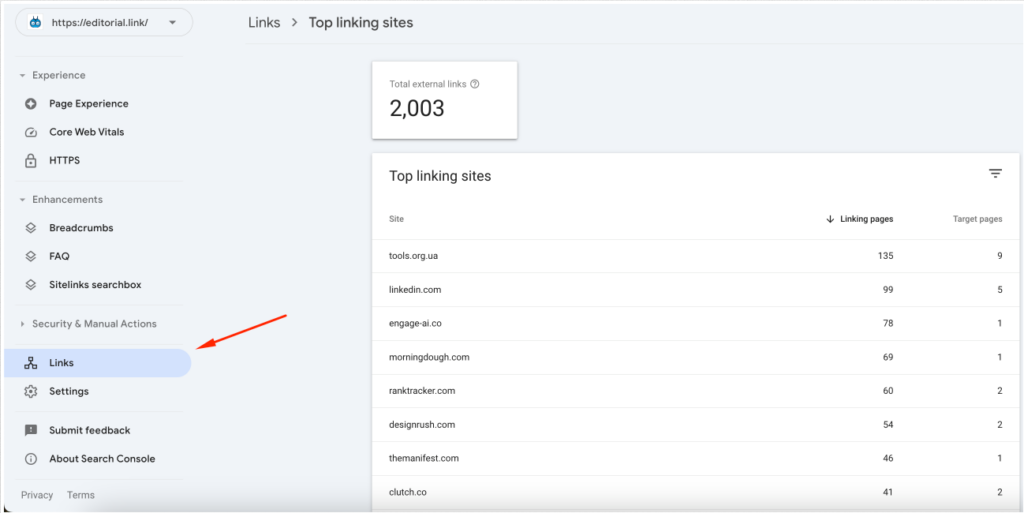
… And exporting them, of course!

As an extra step, make sure to combine the effort by collecting links from trusted SEO tools like Ahrefs and Semrush.
💡Pro-tip! Why take a mixed approach? Well, each method complements the others. For example, every SEO tool has its own unique crawling bots, so links that might be missed by Ahrefs could be spotted by Semrush. Why not double-check your audit for extra coverage?
👉 Step 2: Create a disavow file
To submit all the pre-selected links, just gather all dubious domains in a .txt file — this is the format the tool accepts. It should look something like this:
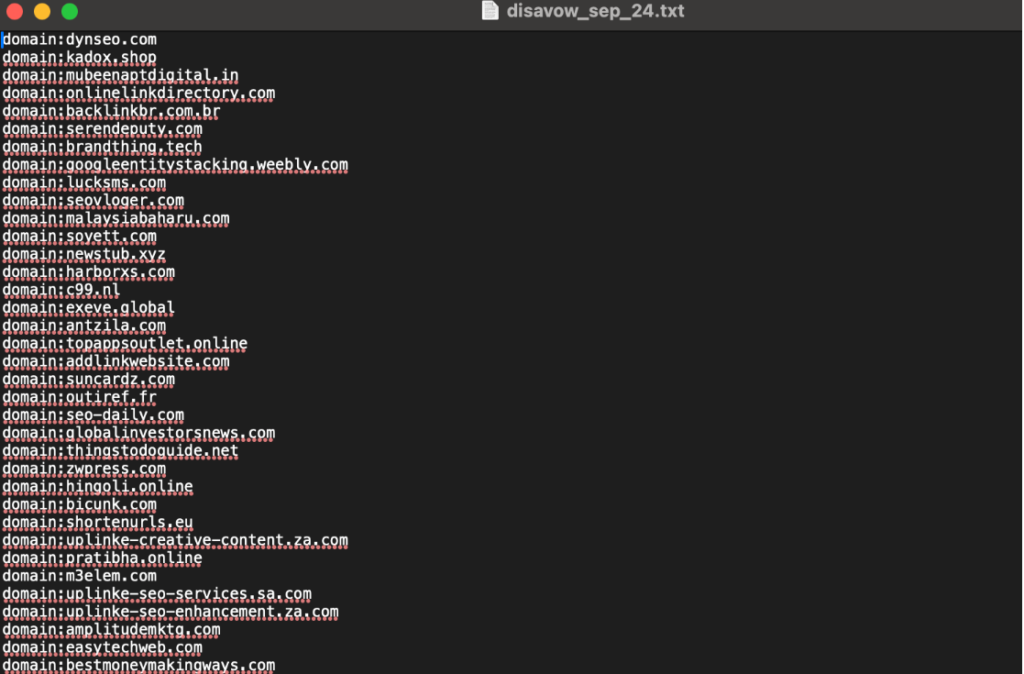
👉 Step 3: Upload your file to GSC
When you go to GSC, the tool will ask you to choose the property type.
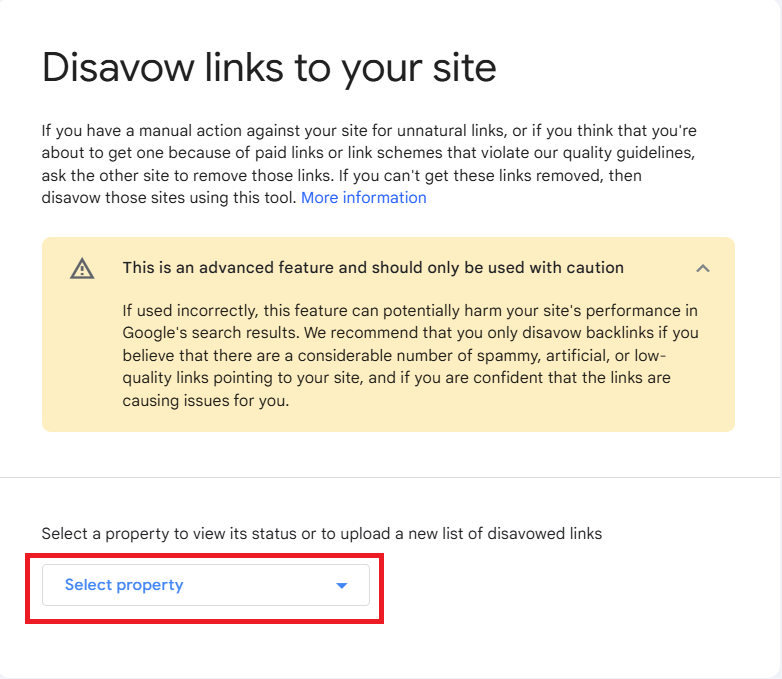
It could be either a domain or a URL. Once you choose your option, you can upload your .txt file with the links you want to disavow.
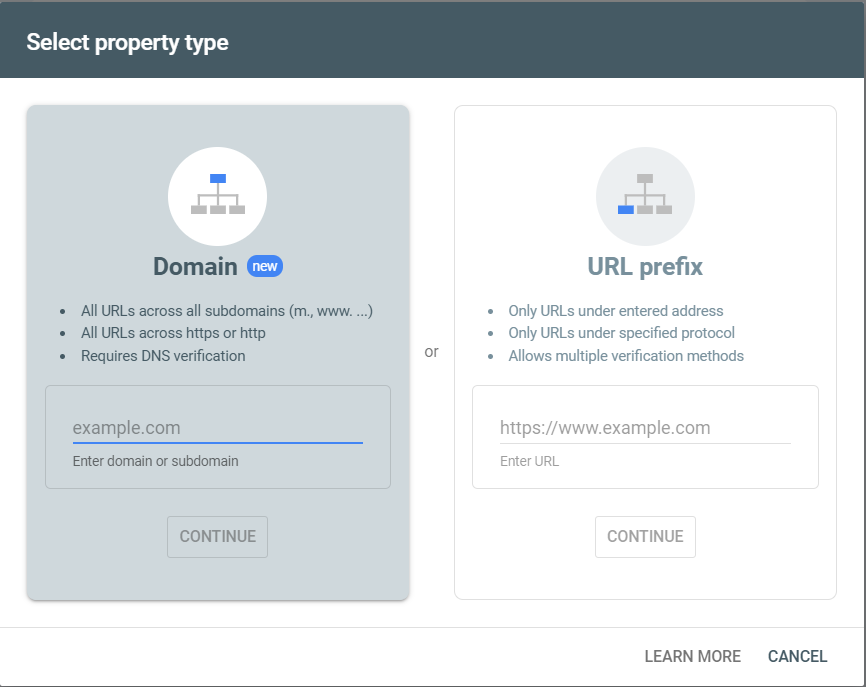
And that's exactly how we did it for Editorial.Link!
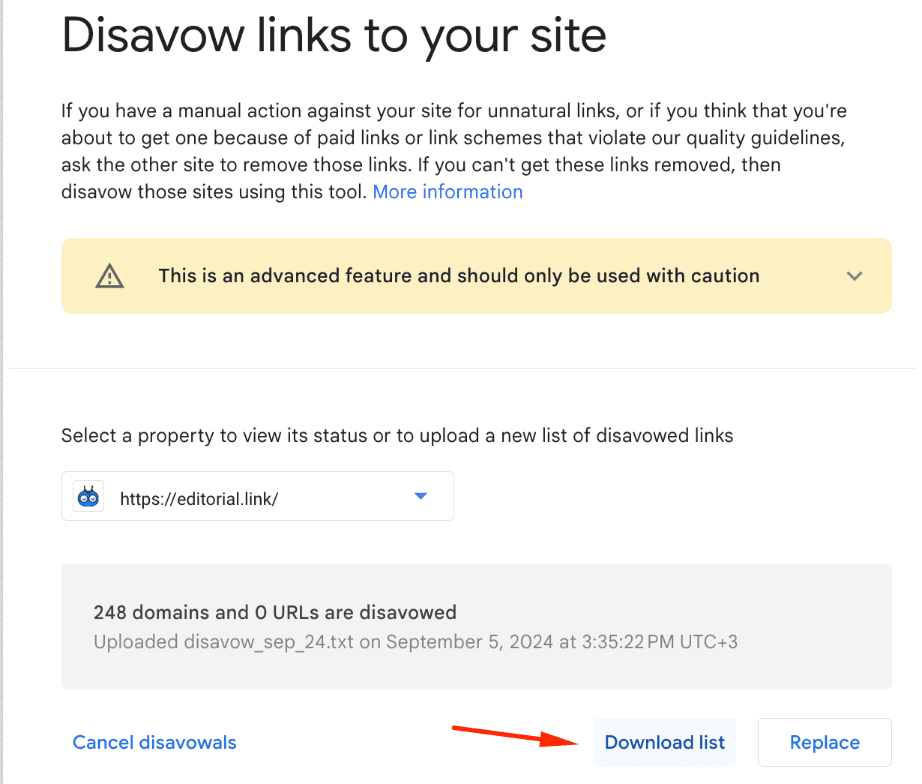
Now, let’s wait for the results! Speaking of wait time…
How Long It Takes to Disavow a Link?
In our experience, on average, we start seeing ranking improvements around 2-3 months after bad links were submitted for disavowing. In this regard, we´re totally on the same page with Neil Patel 🤝 💼
The effect of a disavow link takes anywhere from a few days to process and up to 2-3 months for you to start seeing results. If you’ve been struggling with bad spam links damaging your traffic, you need to respond quickly.
But to be dead honest, it really depends on each case. Much like the debate over using or not using the Disavow Tool — actual practical experience among SEOs on how quickly links get disavowed can really vary.
Some SEO experts say you can't know for sure — nobody can really tell the ways of Google, and that's fair enough.
There’s no real number for that, unfortunately. It just depends on how long it takes Google to process it. And if the algorithm ignores it, it won’t be noticeable right away. I’ve seen them removed in as little as a few weeks, but there’s no solid number to my knowledge.
Others rely on Google’s alleged indexing speed to predict the first results:
Once you’ve spotted the harmful link, using Google’s Disavow Tool is a quick process — usually just a few hours to create the disavow file. So, while the action is fast, the full impact might take 3-4 weeks or longer, mostly depending on Google’s indexing speed.
A good number of opinions suggest that timing depends on the website's current link profile and credibility:
Typically, it’s not an instant fix. You might start to notice improvements within a few weeks, but it often takes a couple of months or even longer for Google to process the disavow file and recalibrate your site’s link graph. This delay is due to how the search engine’s algorithms reassess your site’s link profile and its trustworthiness.
Strictly orthodox SEOs believe that Google responds immediately to backlinks posing the highest spam threat, while taking a slower approach with links that, though potentially manipulative, are less detrimental.
Acutely spammy links, like those from link farms and schemes, can often be dealt with by Google in a matter of hours. It’s the manipulative links that are less obviously harmful that tend to take longer to address.
⚠️ Bottom Line ⚠️ Whatever the reality is for each specific case, hope for the best — a few days or weeks to see positive changes — but be prepared for the worst: it might take months for your disavowed links to make an impact.
Wrapping Up
Now that you’re up to speed on the ins and outs of backlink disavowing, deciding whether to go for it really comes down to your website’s specific needs.
While many SEOs recommend avoiding backlinks disavow, stick to the basics: when facing real manual actions or a flood of spammy links, it’s time to take control — especially if you’re not a big site that gets indexed frequently.
And hey, if anything goes wrong with your links, Editorial.Link is always here to get you some better ones!












